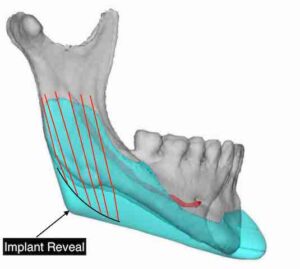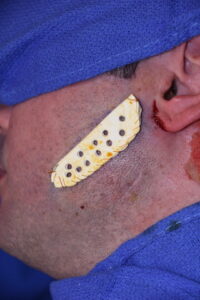Aesthetic augmentation of the posterior jawline consists of various implant options to overlay the bony jaw angle or mandibular ramus. The submuscular placement of the implant on the bone is the logical placement as the goal is to increase the size and shape of the bone. While this is a very effective technique it is not without complications…one of which directly works against the goal of a jaw angle implant.

There are a variety of methods to treat this aesthetic type of jaw angle soft tissue deficiency of which the most common are injectable fillers and fat. Besides the temporary effect of synthetic fillers and the unpredictability of injected fat retention, surgical efforts to try and bring the muscle back over the implant rarely. work…and leave neck scars in the process to try and do so.


The implant is usually custom designed based on the outline of the external soft tissue contour deformity and an estimate of how much thickness is needed. The greatest thickness is located over the jaw angle region and feathers out to the posterior, superior and anterior ends. If it exists on both sides it often has different shapes between the two sides.
The placement of ultrasoft silicone jaw angle soft tissue implants, like Alloderm and ePTFE, can be placed through a 1 cm direct incision or from one around the earlobe. In men int particular the beard skin heals so well that the direct approach is preferred. A subcutaneous skin flap is raised with facelift scissors mainly the created pocket no bigger than the external skin marks. The implant can have perfusion holes placed if desired, which I prefer to usually do to allow for tissue ingrowth and soft tissue intraimplant fixation.
Getting the implant into good position is obviously a key step and is best aided by the small incision at the back end of the jaw angle area. If the pocket is not overextended implant introduction into the pocket is all that is needed. Suture fixation to the muscle can also be done if desired. Closure of the skin incision is done in two layers with small resorbable sutures.

Dr. Barry Eppley
Indianapolis, Indiana






